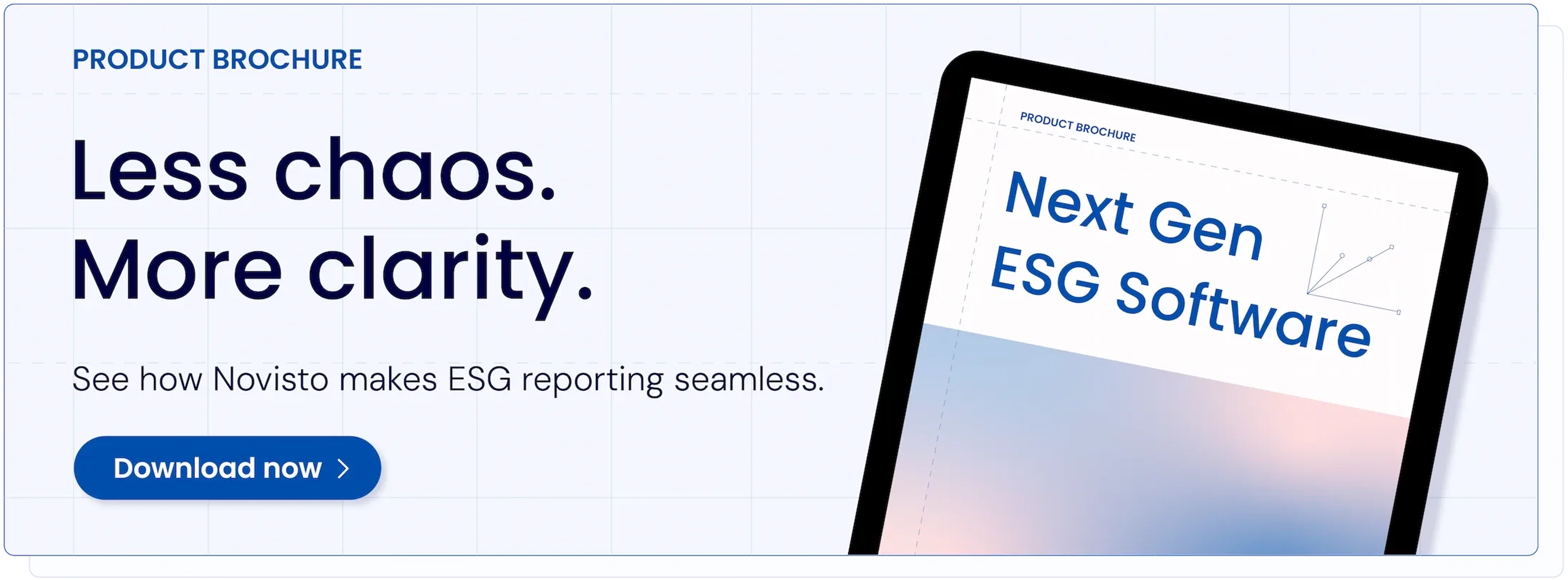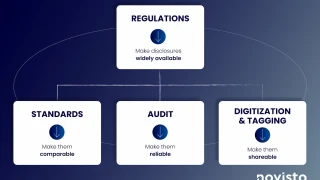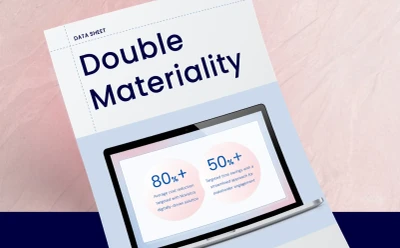Navigate the CSRD reporting era with ease
The CSRD is raising the bar for transparency in sustainability reporting, reshaping who discloses what, and when. Here’s what you need to know to get ahead.
What is the Corporate Sustainability Reporting Directive (CSRD)?
Introduced in 2021 and phased in from 2024, the CSRD is a European Union directive mandating ESG disclosures under the European Sustainability Reporting Standards (ESRS). As part of the European Green Deal, the EU launched the Sustainable Finance Action Plan to shift investment toward a climate-neutral, resilient economy. The CSRD is central to this effort, strengthening sustainability disclosures and expanding on the scope and depth of its predecessor, the Non-Financial Reporting Directive (NFRD).
Recent amendments proposed by the Omnibus package reduce the number of companies required to report under the CSRD by roughly 80% and bring significant changes to its application. While some original requirements remain, others have been streamlined or postponed, reshaping how and when companies must comply.
What’s the goal of the CSRD?
Inconsistent and limited sustainability data under the NFRD, along with rising climate risks, have created the need for more widely available and reliable corporate disclosures. Thus, the primary purpose of the CSRD is to give investors and other stakeholders clearer insight into companies’ material impacts, risks, and opportunities. This will help stakeholders better evaluate a company’s overall sustainability performance, including the impact of climate change.
By requiring companies to disclose standardized ESG data in their annual management reports, the CSRD is raising the bar on transparency and accountability. Consequently, this will empower stakeholders to make more informed decisions and support the transition to a more sustainable economy.
The Omnibus: Streamlining EU sustainability rules
On February 26, 2025, the European Commission published the first Omnibus package, proposing amendments to major EU sustainability laws—including the CSRD, CSDDD, and EU Taxonomy Regulation. Its main goal is to lower compliance costs and ease the reporting demands on companies, helping unlock savings and making regulatory obligations more manageable.
Key CSRD amendments include postponed reporting times and simplification of the sector-agnostic ESRS.
Which companies are in scope?
The CSRD’s scope and timelines have undergone significant changes following the EU’s 2025 Omnibus package and its multiple proposals1. This includes the Simplification Proposal and the “Stop-the-clock” directive2, introducing reliefs and delays to enable a smoother transition for companies.
Summary of reporting timelines and directive impacts by wave
Wave | Before Omnibus | After Omnibus | Original reporting timeline | Impact of “Stop-the-Clock” directive | Impact of Simplification directive |
|---|---|---|---|---|---|
Wave 1 Formerly NFRD companies | Large listed companies with more than 500 employees | Large listed companies with more than 1,000 employees | 2025 (reporting on financial year 2024) | No changes in reporting timeline | Report under revised ESRS with some reliefs provided by the recently adopted delegated acts (Quick Fix) |
Wave 2 | Large private companies
| Large private companies with more than 1,750 employees and more than €450 million net turnover | 2026 (reporting on financial year 2025) | Reporting delayed by 2 years | Report under revised ESRS with some reliefs provided by the recently adopted delegated acts (Quick Fix) |
Wave 3 | Listed SMEs, certain small and noncomplex credit institutions, and certain captive insurance and reinsurance entities.
| Omnibus proposal excludes SMEs | 2027 (reporting on financial year 2026). | Reporting delayed by 2 years | Can switch to Voluntary disclosure under the VSME |
Wave 4 | Non-EU companies with significant EU activities:
| Non-EU companies with significant EU activities:
| 2029 (reporting on financial year 2028) | No changes in reporting timeline | Revised ESRS |
- Subject to change as Omnibus proposal updates are ever evolving
- The Directive was cemented into law by the European Council in April 2025. Notably, Wave 1 companies remain on the original timeline while other waves benefit from the extension.

What are the ESRS?
Developed by the European Financial Reporting Advisory Group (EFRAG), the ESRS set out the detailed disclosure requirements under the CSRD, covering environmental, social, and governance topics. To support and promote global harmonization and convergence—and reduce double reporting—the ESRS were designed to ensure a high degree of interoperability with the GRI and the IFRS Sustainability Standards, particularly within their climate-related disclosure requirements. Moreover, the ESRS are highly interoperable with both the TCFD and TNFD frameworks: all TCFD climate-related pillars and the full set of 14 TNFD recommended disclosures are addressed within the ESRS, using consistent concepts, structure, and metrics.
Under the proposed 2025 Omnibus package, the ESRS remains mandatory for all large, in-scope companies, but certain requirements have been phased in or deferred. For instance, Wave 1 companies benefit from “quick-fix” relief, allowing them to defer some of the most complex disclosures—such as the four topical standards (E4, S2, S3, S4)—until FY 2025 and FY 2026.
More recently, EFRAG has taken steps to streamline the standards. In July 2025, it published twelve draft revisions for public consultation, proposing to cut their overall length by over 55%, reduce disclosure requirements by 68%, and remove 57% of mandatory datapoints where they are not material. These efforts aim to make the ESRS more focused, usable, and less burdensome for companies.
The deadline for finalizing and implementing the simplified ESRS revisions is targeted for late 2025 or early 2026.
ESRS cross-cutting standards
The cross-cutting standards, ESRS 1 and ESRS 2, establish the core requirements of all ESRS reporting and apply universally across all sustainability topics and sectors.
ESRS issue-specific standards
The issue-specific ESRS or “topical standards” cover specific sustainability topics, are industry agnostic, and correspond to the targets and metrics pillar of the TCFD. Companies are only required to report on topics that are material to their operations. Notably, ESRS E1 is the only standard that isn’t subject to the DMA; however, even if not reported to be material, companies will still need to explain why.
ESRS sector-specific standards
Sector-specific ESRS were originally intended as additional standards tailored to industries such as oil & gas, mining, agriculture, transportation, and textiles. These standards were meant to capture impacts and risks common to all companies in a given sector but not fully addressed in the general, sector-agnostic ESRS.
Their rollout was initially postponed to July 2026 to give companies time to implement the core ESRS. However, under the 2025 Omnibus reforms, the European Commission proposed removing the requirement for separate sector-specific standards altogether. EFRAG has since taken them off its work plan, shifting focus to refining the existing cross-cutting and topical ESRS so they can accommodate sector nuances.
A new era of elevated sustainability reporting

Other CSRD reporting requirements
Double Materiality Assessment (DMA)
To comply with the ESRS, companies must disclose sustainability information following the “double materiality” principle. This entails conducting a due diligence assessment to identify material impacts and dependencies on people and the environment (impact materiality), as well as material risks and opportunities for the business itself (financial materiality).
Only topics deemed material need to be disclosed, except for climate change and Principle Adverse Impact (PAI) indicators, which always require explanation if excluded.
Simplify your double materiality assessment with Novisto’s DMA solution.
Third-party assurance
Companies subject to the CSRD must obtain independent, third-party assurance of their sustainability data. Currently, only limited assurance is required. Following the latest Omnibus update, the transition to reasonable assurance has been put on hold until at least 2028.
Limited assurance focuses on the process used to compile the reported information, using procedures like inquiry, observation, and analytical review, and does not require the same level of detailed testing and evidence as reasonable assurance.
Learn about other CSRD guidelines in our comprehensive Research Note.
XBRL tagging
Under the CSRD, all in-scope companies are required to submit sustainability reports digitally, using standardized XBRL tags instead of traditional PDF or paper formats. These reports must align with the ESRS XBRL taxonomy, making the data both human- and machine-readable. This ensures broad accessibility and usability for stakeholders and regulators. This helps make data widely accessible and usable for stakeholders and regulators.
EFRAG has already published the ESRS Set 1 XBRL taxonomy, with the next step being the European Commission’s formal adoption via a delegated act.
Go deeper with our XBRL reporting blog post.
Stay in the know with the latest CSRD updates
November 18, 2025 - Negotiations commence with EU Government
The Trilogue process commenced with the aim of finalising amendments to the existing CSRD and CS3D by the end of 2025.
↓
November 13, 2025 - EU Parliament votes to adopt Omnibus amendments.
The amended Directive must now pass through a review process with the European Parliament, the Council of the European Union, and the European Commission.
↓
July 31, 2025 - EFRAG issues draft ESRS simplifications.
EFRAG publishes its draft revisions to the ESRS, aimed at creating a more focused and practical sustainability reporting system under the CSRD.
↓
July 29, 2025 - VSME recommendation is adopted.
The EU Commission makes it easier for SMEs outside the CSRD’s scope to respond to sustainability information requests from large firms & financial institutions.
↓
July 11, 2025 - ESRS ‘Quick-Fix’ amendments adopted.
The EU adopts the ESRS ‘quick‑fix’ Delegated Act to ease the initial reporting scope for Wave 1 companies, freezing additional requirements for 2025–2026.
↓
April 14, 2025 - ‘Stop-the-clock’ becomes law.
The EU Council formally postpones CSRD reporting for Wave 2 and Wave 3 companies by two years, while leaving the Wave 1 deadline unchanged. Member states have until the end of 2025 to transpose these changes into national law.
↓
March 26, 2025 - Stop-the-clock directive is approved.
The European Council endorses the European Commission’s proposed directive, delaying implementation of both the CSRD and CSDDD.
↓
February 26, 2025 - Omnibus is introduced.
The European Commission adopts the Omnibus package, amending the CSRD, CSDDD, and EU Taxonomy.
CSRD reporting FAQs
Start preparing for the CSRD today
Whether you’re just launching your CSRD journey or refreshing your compliance toolkit, Novisto has you covered. Visit our CSRD page, request a demo, or download our Solution Overview to learn more.
